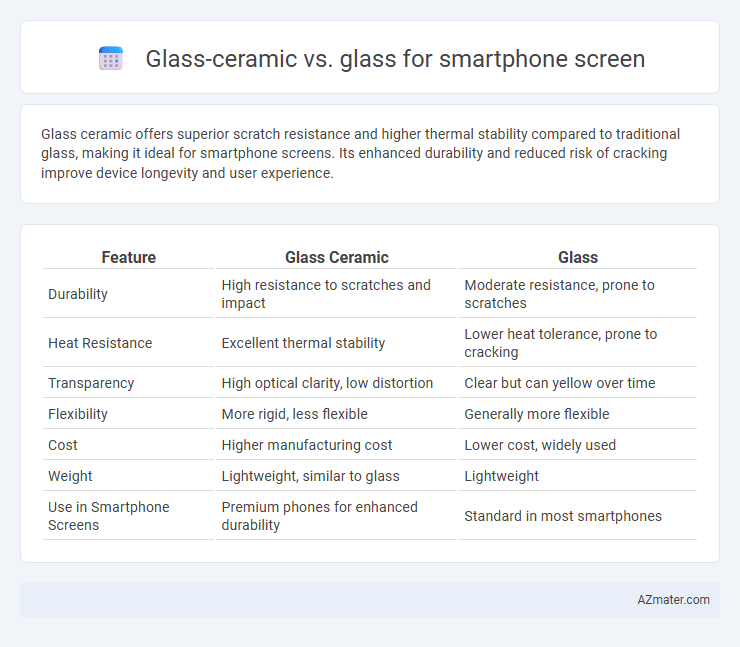Glass ceramic offers superior scratch resistance and higher thermal stability compared to traditional glass, making it ideal for smartphone screens. Its enhanced durability and reduced risk of cracking improve device longevity and user experience.
Table of Comparison
| Feature | Glass Ceramic | Glass |
|---|---|---|
| Durability | High resistance to scratches and impact | Moderate resistance, prone to scratches |
| Heat Resistance | Excellent thermal stability | Lower heat tolerance, prone to cracking |
| Transparency | High optical clarity, low distortion | Clear but can yellow over time |
| Flexibility | More rigid, less flexible | Generally more flexible |
| Cost | Higher manufacturing cost | Lower cost, widely used |
| Weight | Lightweight, similar to glass | Lightweight |
| Use in Smartphone Screens | Premium phones for enhanced durability | Standard in most smartphones |
Introduction to Smartphone Screen Materials
Glass ceramic for smartphone screens offers enhanced durability and scratch resistance compared to traditional glass, making it a superior choice for protecting displays. Its unique composition combines the optical clarity of glass with the toughness of ceramics, resulting in improved impact resistance and reduced chances of screen shattering. Smartphones utilizing glass ceramic screens benefit from longer lifespan and better performance under everyday wear and tear.
What is Glass Ceramic?
Glass ceramic is a material that combines the transparency of glass with the durability and thermal stability of ceramics, making it highly resistant to scratches and impacts. Unlike conventional glass, glass ceramic undergoes controlled crystallization during manufacturing, resulting in a microstructure that enhances strength and reduces the risk of shattering. This unique composition makes glass ceramic an increasingly popular choice for smartphone screens, offering improved durability and longevity compared to standard glass displays.
What is Traditional Glass?
Traditional glass used in smartphone screens is primarily composed of silica-based materials, offering transparency and hardness but lacking the durability required for resistant display panels. Glass ceramic, in contrast, incorporates crystalline structures within the glass matrix, enhancing strength, scratch resistance, and thermal stability without compromising clarity. This makes glass ceramic a superior choice for modern smartphone screens seeking better impact resistance and longer-lasting performance.
Key Differences Between Glass Ceramic and Glass
Glass ceramic offers superior scratch resistance and thermal stability compared to traditional glass, making it more durable for smartphone screens. Unlike standard glass, glass ceramic has a crystalline structure embedded within the glass matrix, enhancing resistance to impacts and reducing the likelihood of shattering. This material also provides better clarity and can withstand higher temperatures during manufacturing processes, improving the overall performance and longevity of smartphone displays.
Durability and Scratch Resistance
Glass ceramic offers superior durability and scratch resistance compared to traditional glass in smartphone screens, due to its crystalline structure that enhances hardness and resistance to impact. This material is less prone to cracking and can withstand higher levels of stress from drops and everyday use. Glass ceramics also maintain clarity and smoothness over time, reducing the visibility of scratches and extending the lifespan of the display.
Impact Resistance and Drop Protection
Glass ceramic offers superior impact resistance and drop protection for smartphone screens compared to traditional glass, due to its crystalline structure that enhances toughness. This material demonstrates higher fracture toughness, reducing the likelihood of cracking or shattering upon impact. Smartphone screens made with glass ceramic provide enhanced durability against everyday drops and accidental impacts, significantly improving device longevity.
Optical Clarity and Display Quality
Glass ceramic offers superior scratch resistance and enhanced durability compared to traditional glass, maintaining optical clarity under prolonged use and exposure to harsh conditions. Its lower thermal expansion coefficient reduces distortion and preserves display quality by minimizing stress-induced warping, resulting in sharper images and consistent color accuracy. Glass ceramic's smoother surface ensures minimal light reflection and glare, improving visibility and brightness for a more vibrant and clear smartphone display.
Weight and Design Flexibility
Glass ceramic offers significant advantages over traditional glass in smartphone screens by providing a lighter weight, enhancing overall device portability without compromising durability. Its superior design flexibility allows for more innovative shapes and thinner profiles, enabling manufacturers to create sleek, ergonomic designs that are difficult to achieve with conventional glass. This combination of reduced weight and versatile design makes glass ceramic an ideal choice for next-generation smartphones focused on both aesthetics and user comfort.
Cost and Manufacturing Considerations
Glass ceramic screens often incur higher production costs due to complex manufacturing processes involving controlled crystallization, resulting in enhanced durability and scratch resistance compared to traditional glass. Standard glass, such as Gorilla Glass, benefits from established mass production techniques, reducing unit costs and manufacturing time. Choosing glass ceramic may increase initial investment but provides long-term value through improved longevity and resistance to damage.
Which is Better for Your Smartphone?
Glass ceramic offers superior scratch resistance and enhanced durability compared to traditional glass, making it a better choice for smartphone screens prone to daily wear. Its high thermal stability reduces the risk of cracking under temperature fluctuations, ensuring longer-lasting screen integrity. While glass screens provide excellent clarity and touch sensitivity, glass ceramic's toughness and resilience make it a more reliable option for smartphone users seeking durability and protection.

Infographic: Glass ceramic vs Glass for Smartphone screen
 azmater.com
azmater.com